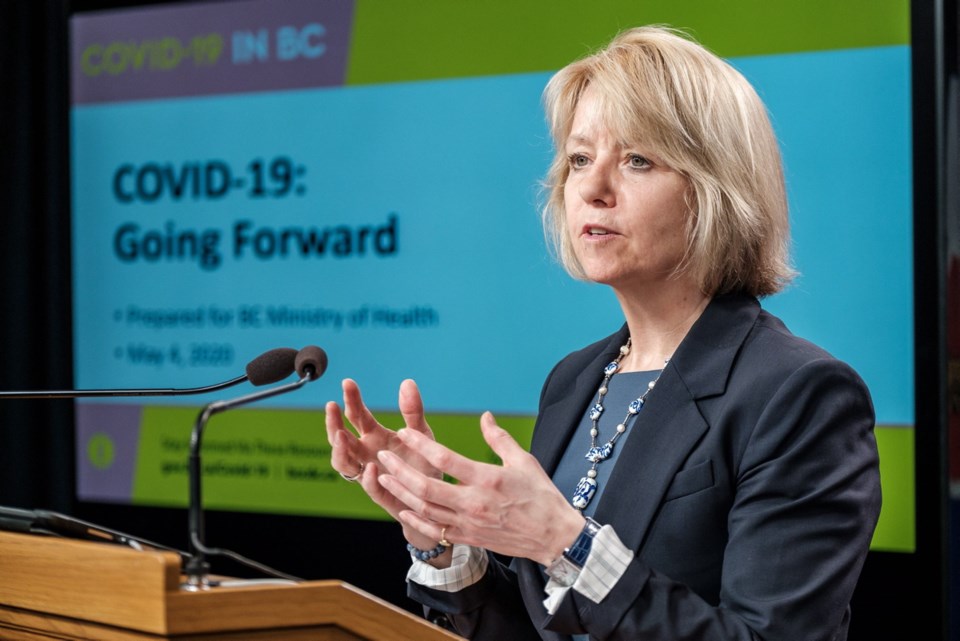About 70 per cent of social interactions in B.C. have been curtailed through the overall response to the pandemic, and success in curbing it has set the stage for some resumption of contacts.
Provincial health officer Dr. Bonnie Henry led a briefing Monday on encouraging trend lines that set the stage for a careful return to some forms of getting together with other people. More details about when are expected Wednesday.
The key factors in relaxing some of the restrictions are the case count and the hospital system’s capacity for handling COVID-19 patients if it increases.
Both those factors now allow for increasing social contacts. The number of new cases peaked in mid-March and Henry said there has been a “dramatic and sustained” decrease since then.
Even with critical care bed surge capacity reduced in the last two weeks, there are still many beds available. There were 704 such beds by the most recent count and 314 were occupied, only 20 of them by COVID-19 patients as of Monday.
The number of them ill enough to require ventilators is now nine, down from a peak of 54 in the first week of April.
Those and other indicators suggest it will be relatively safe to resume some social interactions.
The main interactions outlawed are by way of closures of schools, the personal service industry, dine-in restaurants and bars, and gatherings of more than 50 people.
Some of the others, like working from home and avoiding non-essential travel, are recommendations.
Henry and Health Minister Adrian Dix are working from what they called “dynamic compartmental modelling.” Those are graphs of different scenarios suggesting what would happen to the pandemic patient count after returning to various degrees of “normal.”
Holding social interactions to 30 per cent of normal, which is the current estimate, would drive the patient count down even further. Going to 80 per cent of normal, on the other hand, would allow it to skyrocket, according to the projections.
The “sweet spot” is around allowing 60 per cent of normal contact. A return to 60 per cent of pre-pandemic social contacts would mean roughly doubling the amount of contact now allowed. But there were no definitions of what that involves exactly.
Henry said it will involve allowing for more contacts in a safe way. That will mean more Plexiglas shields like the ones used at many of point of sale counters. There will be occupancy limits on many more buildings to allow for more space and more markers indicating two-metre separation. There will also be far more stringent rules, if not laws, against working while having illness symptoms.
She said there is room to increase “our work, our school and daycare and childcare,” if strict new hygiene measures are stressed.
“Our challenge is to find that sweet spot around … increasing our contacts by twice as many as we have now, but without allowing those opportunities for exponential growth of the virus.”
She said physical distancing “has allowed us to put the brakes on COVID-19. But we haven’t stopped the car.
“And it’s very unlikely that we’re going to be able to, at least in the coming months. There’s so much that we actually don’t yet know about this virus.”
One of the charts presented Monday showed that despite the huge effort of contact tracing, during the big surge of new cases in March, a significant share of the cases were from “community transmission of unknown source.”
The social contact estimates at this point look like rough estimates. A briefing last month on the effect of the public health interventions used Google mobility reports on retail, transit, workplace and residential travel to gauge social distancing.
The finer points are expected on Wednesday. The first monumental decision on this pandemic was on the drastic curtailment of ordinary life. By and large, it worked.
The second big one will be on how to gradually re-open for business. It’s just as important as the first one.
- - -
To comment on this article, send a letter to the editor.
Send us your letters
• Email: [email protected]
• Mail: Letters to the editor, Times Colonist, 2621 Douglas St., Victoria, B.C. V8T 4M2.
Letters should be no longer than 250 words and may be edited for length, legality or clarity. Avoid emailing your letter as an attachment. Please include contact information; we require your first and last name and the municipality where you live for the letter to be considered for publication.



